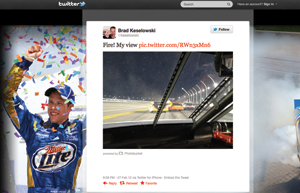In two areas of life, the term “user” universally applies: drugs and computers.
The addictive qualities of social media, particularly Twitter, have many of us in its clutches, albeit in a predominantly productive fashion. With more than 100 million registered users in the U.S., sending 175 million tweets a day — thousands every second — Twitter can be a very powerful communications and promotional tool, but only if used carefully and strategically.
Twitter is a medium of contradictions: direct and intimate, while also global in reach. (Just ask former Aflac spokesman Gilbert Gottfried). With the Twitter playbook still evolving, based on ham-fisted trial and red-faced error, here are sundry observations for sports professionals on Twitter seeking to extend their brand … and their employment:
■ Our special obligation: Many of us tweet from a company-owned device, possibly using a brand handle. This brings fortuitous opportunity (built-in branding that bestows credibility and helps attract followers) as well as definite obligations. Mainly, you’re expected to properly represent your company, making each cyber burp a mini-ad brilliantly spreading your message … or packed with potential to explode in your face.
■ You’re not Chris Rock … or Tony Kornheiser: Another Twitter contradiction: The quickest way for non-celebrities to gain followers is to be quick-witted and provocative. Subjective musings, however, are a fast track to offending someone, somewhere with a sticky retweet finger. Walk the tightrope, and you’re sure to fall off. Shun the perennial minefields of racial, religious, political and sexually explicit jokes.
But there’s more to keeping legal at bay and your family fed than going easy on the stand-up act. Sharp opinions may be the magnetic currency of sports talk, but on social media, sniping at people, brands and events inevitably causes problems. No one expects tweets exclusively from @Stepford. Yet, declaring a game boring, a coach inept, or a sponsor clueless elevates no one. Fly Me Airways may have dimwittedly lost your bag, but your sales team is likely pitching them a sponsorship. Get some air before becoming “the angry guy on Twitter.”
■ I, Me, Mine: Be authentic, be yourself, and call attention to that. If you are posting individually without a corporate affiliation, add to your profile language specifying these tweets are your personal thoughts, not representing your company. If this is the only advice you follow from this column, it has been worth reading it.
■ Review before retweeting: Retweets can imply endorsement. Be careful with “pass along” links that can be perceived as your company’s content or opinion. It’s impossible to fact check everything. At the minimum, read the entire article before retweeting. Let’s learn from the unfortunate chaos surrounding Joe Paterno’s prematurely announced passing due to mass pass-along of an inaccurate source story.
■ Check your facts and spelling: This is obvious but sometimes lost in rushing out content from a handheld. (See @IMGCollege misspelling “Purdue” as “Perdue.” Coast-to-coast cackling followed, with tough-man/tender-chicken references used to attain cyber forgiveness.)
■ In a sharing culture, nothing is personal: I had emailed a hilarious off-color video to a reporter that was promptly tweeted “from @IMGCollege.” Once I came to and dragged myself off the floor to reach the phone, she instantly empathized with career-flashing-before-the-eyes desperation and deleted the post. #TeachableMoment: When direct messaging or using email, stipulate whether content shared is meant to go public.
■ Don’t steal: You may covet thy follower’s pithy insight, but don’t pilfer it without attribution. Sports are an intellectual property business. Respect our unwritten constitution, and always credit the thoughts of others. If for no other reason, you’ll sooner or later be exposed as a thief.
■ Make use of your position: As an executive in sports, you’re uniquely positioned to deliver content attractive to current and potential followers, whether they’re media, fans, potential employees, or possible business partners. You can offer:
 |
Brad Keselowski took advantage of his position at the Daytona 500 to tweet live images. You can offer your own perspective through your position in sports business.
|
• Fresh reporting: What we hear from players, coaches, officials, owners, pundits or sponsors (so long as they’re comfortable with widely sharing).
• A different perspective: You don’t have to be @BradKeselowski photo-tweeting a fireball from his race car during a NASCAR red flag to offer your own interesting insights and environmental observations. For example, IMG Audio’s @GamecockRadio provides tweets from our play-by-play announcer as he’s calling the game.
• Owned IP: Links to audio or video clips, behind-the-velvet-rope photos, exclusive interviews, or game-winning buzzer beaters. Use Twitter to share new research and brand information as well as to break bona fide news.
• Organizational peepholes: Counterintuitive stats and fun anecdotes about your job. Most of us don’t attend SI’s swimsuit shoot, but we can share dispatches from other walled-off VIP locations that ordinarily are taken for granted.
• Interactivity: Contests, questions and calls for suggestions can encourage valuable interplay with your audience.
■ Be strategic: Some tweet because everybody’s doing it. Fair enough, but why not take Twitter to another level to drive your business and communications goals? Ask yourself: Why am I on Twitter? What can my organization accomplish? How can we serve our constituencies? Which messages can we share? Then, match social-mediated content to fit your objectives.
In an ever-changing “brave new world,” if our 140-character proclamations align with communications goals, and we’re keeping it clean and virtuous, the smart money says sports execs will all be successful on Twitter.
Now we just have to figure out Pinterest.
Andrew Giangola is vice president of strategic communications for IMG College. Follow him on Twitter @IMGCollege.





